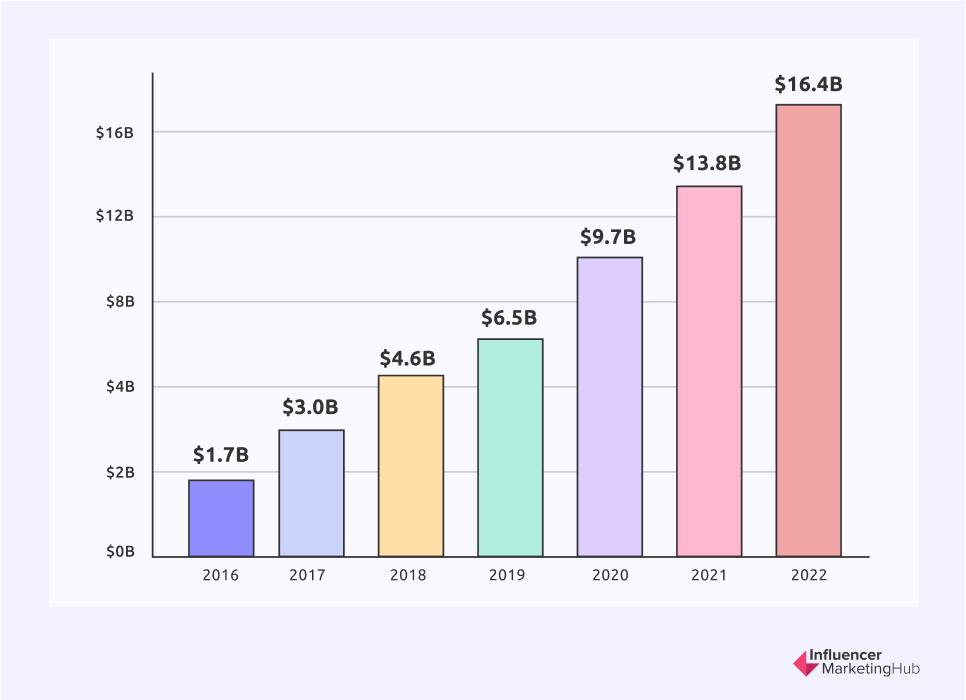If you’re an eCommerce brand and you’re reading this, I have one thing to suggest… influencer marketing. Why? The success of influencer marketing is no secret, with the market growing from $1.7 billion in 2016 to $13.8 billion in 2021. In 2022 the market is projected to expand to a huge $16.4 billion industry.

While influencer marketing is clearly lucrative, it’s also pretty new. This means the tactics and approach are still a work in progress and this can leave brands second-guessing the value. That’s where influencer seeding comes in. Not sure what that means? No problem. Let’s take unpack what it is and look at why it works.
Out with gifting, in with influencer seeding
“Hey, here’s my product but in exchange, I want a product review post.” Although dubbed a gifting program, it is still pretty transactional, right? It’s basically the same as offering $500 for a post.
This method may leave you with a bunch of one-off posts but it rarely produces the desired outcomes or ROI. It can also be incredibly disappointing because there’s no visibility, there’s no attribution, and you don’t know if it did anything or brought in sales. They end up feeling like it was a waste of money.
So what’s the proper system? You guessed it, it’s influence seeding.
Influencer seeding explained
This approach is more brand-centric, where the product is the focus instead of money, contracts, and negotiations. In short, it’s putting your product into the hands of influencers without any promises from them. Sounds risky? There’s no denying it carries a risk but these content creators are also hungry for good content and love good products.
The reason that you want to let the product be the focus is you want genuine advocacy. It’s what everyone wants when they start with influencer marketing. They want, authentic people that love the product or the brand, it’s the first and most important step to building an influencer community.
What does it cost?
The immediate question when I suggest this approach to brands is “How much is this going to cost me?”. It’s a fair question but the question I ask back is “What can you afford?”.
To work this out, we start with the Cost of goods sold (COGS) plus shipping, to work out what it costs to get the product to the influencer’s door. We then take that number and times it by the number of influencers we’d like to target. So, if it’s 100 influencers and your COGS are $25, that’s $2,500 that you’d be dedicated to influencer seeding.
It’s a numbers game. So the more that you can afford to send out products, the more success you can expect from your outreach. What we’re really wanting is to plant the seed and hope that it’ll blossom into a long-term relationship flower.
The real value of influencer seeding
Good influencers are hounded by brands all day long, and most of the offers they receive are very transactional, outreach messages. More often than not, the influencer hasn’t even heard of the brand before and they simply offer a free product in exchange for a post. It doesn’t sound very tempting, does it? 90% of the products are likely things they’d don’t want or need anyway.
But with seeding, and allowing the product and brand to be the focus, you’ll get genuine interest because influencers decide to create the content because they want to, rather than because they are contracted to.
So while you’re not guaranteeing content like with gifting or paid programs, you’re getting far better quality because they actually loved your product. Let’s say there’s a scenario where out of 100 products that you offered to send out, you get 20 who agree to receive it. Of that 20, you should expect 30% (6 people) to post content without you asking. And you’ll likely get a few posts from each of them. If we call that 15 content pieces, that’s 15 more assets you didn’t have yesterday.
So if you have $25 dollar COGS, you send products to 20 influencers (that’s $500) and you get 15 total assets out of that, that’s only $33 per asset. You won’t find professional, genuine content that cheap, anywhere these days.
If you’re concerned about sending out free products. Think about the fact that you’re getting cost-effective, great content from professional creators of content and you’re getting it at a constant rate.
Taking content further
It doesn’t end there. There’s more you can you do with all this content. The influencer posts organically, that’s great and is free brand awareness. But as we see with algorithms these days, it’s incredibly confusing and there’s little data so you need to get more out of it.
We suggest taking your assets, reaching out to these influencers, and getting permission to use the content within Facebook ads. And that’s where you actually start to see sales come in. Because user-generated content (UGC) is proven to scale accounts. And influencers are one of the best sources of UGC because they are genuine, you didn’t pay them, and their content will be honest.
So to sum it up. Reach out and build relationships through influence seeding. Only work with influencers that prove to be genuinely interested in your products by using a “no string attached” method. The people that do post can become a flywheel to start working with these creators. Once you see the performance of their content, you can turn them into affiliates or get them on monthly UGC contracts. So while you’re not avoiding paying them, you’ve started the relationship the proper way and you also get a ton of short-term ROI out of it.
If interested in working with Kynship as an influencer marketing agency, you can reach out here: https://bit.ly/Kynship-Agency



